Learn to Work

The Avionics Integration Laboratory of MAI is becoming the first workplace for students who want to try their hands in real business projects. Here, young people are taught to work, whereas fresh ideas and concluded contracts attract new interested people. Search and attraction of talented students from different departments and faculties, in fact, formed an effective mentoring system. “Growing up” and gaining experience, students are becoming leaders and curators for the next generation.
“For some reason, we often think that an integrator is the one who bought something somewhere, mechanically twisted something, and it all worked. In fact, the integrator, having a certain methodical approach and experience, creates rather large and heterogeneous complexes and systems. It is not enough to take an engine and attach wings to it to make an aircraft,” says Dmitry Panyukov, Head of the Avionics Integration Laboratory, a graduate of the Moscow Aviation Institute.
From the large windows of the laboratory, which has an entire floor in the Building 24 on MAI campus, there is a view over Moscow: the loud railway below, Leningradskoe Highway, bridges, cars, and people. The time is near, when drone delivery, aerotaxi will be added to this landscape, and helicopters of medical services and Ministry of Emergency Situations are not uncommon now. It is in the spirit of MAI– to think comprehensively and prepare future engineers for this, to teach them to respond to city, country and market requests.

In 2016, when the laboratory was formed on the basis of the Department 101 “Aircraft Design” of MAI, there were only a few people under the supervision of Dmitry Panyukov. Among them was Kirill Schukin, who worked in his subdivision in the Sukhoi Civil Aircraft Company and returned to the alma mater as well, and Gleb Boyarskiy, now a graduate student of the Institute № 6 Aerospace of MAI. Laboratory work is supervised by MAI Rector Mikhail Pogosian - it is strategic for the university. The main goal was the development of competencies of an integrated approach to the creation of complex systems of not only on-board avionics equipment of aircraft, but also a wider range of solutions that solve specific technical and market tasks.
“The integration of avionics is the first point from which we started,” says Dmitry Panyukov. “Now we have contracts for avionics, on-board equipment. We are also engaged in ergonomics and unmanned systems, complexes using unmanned aerial vehicles (UAVs). There is also a Drone School where specialists make sports UAVs for competitions.”
How the Integrator Sees Drones
The project to develop the concept of an unmanned transport system for the Kronstadt Group has become one of the basic and successfully completed contracts in the laboratory portfolio. The responsibility of this work has given the goal of earning a reputation and expressing itself in the industry.
The specialists started with questions: what product is needed by the market, in which service can be turned into or integrated a UAV system? How to occupy a niche in the market and what you need to do: create a unique solution or cheaper than the existing ones? From the answers to these questions formed the overall appearance of the UAV complex and the composition of its subsystems.
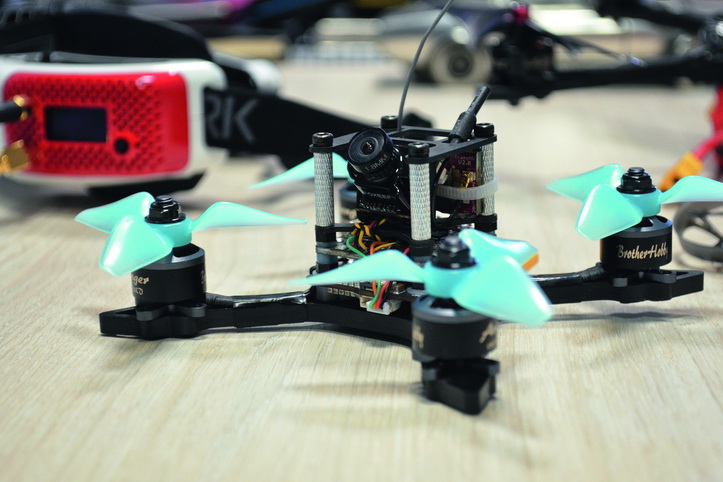
“Within six months, we received new competencies in the field of logistics, economics, aircraft manufacturing, marketing, economics,” says Gleb Boyarsky. “It was necessary to understand the area of applicability, what goods to transport, what will be the advantage of the proposed method of transportation and what ground infrastructure is needed. The economic efficiency of the whole complex in the conditions of market competition was important, and our model turned out to be quite reliable — the most accurate of all that was encountered earlier."
It turned out that for the specific needs of Kronstadt Group - the weight of goods up to 2 tons, the distance of transportation - it is best to use not drones or aircraft of non-standard schemes, but a small high-wing aircraft with a piston engine, without using composite materials. In the laboratory, they worked on the appearance of the high-plane, basic characteristics (engine power, fuselage size, under which they designed the universal container for cargo). In the laboratory, the layout of the high-wing airplane was worked out, basic characteristics (engine power, fuselage size, under which they designed the universal container for cargo). The cost of different design options was and a roadmap for the project was. Customers were satisfied with the results of the work, and now the partnership with Kronstadt Group continues.

“We came to the conclusion that such integration work in Russia is unique,” says Dmitry Panyukov. “In fact, nobody does that. People design and launch drones, everyone is very passionate about it. But the UAV is just an aircraft, one of the elements of the system. Yes, it is very important, but the task of organizing the transport system is much wider. If you do not design the whole complex correctly, you will not be able to choose the drones for it. And you can even set your own requirements for such a drone and develop it."
The laboratories of MAI are ready to be engaged in the development of drones - the capabilities of the university make it possible to create everything up to the experimental batches. And in the Laboratory of Avionics Integration, the development and management of drones developed separately. The first Drone School in Russia was born here.
Evolution in the Cockpit
Indication and ergonomics of the information control field (ICF) in the cockpit is another area of the laboratory's work. Here new approaches to the interaction of pilots with electronics are developed and experimental software, hardware solutions and mock-ups are created, and also software for functional modeling of the systems in different conditions is deeply developed: with the help of a software model, you can “drive” the aircraft which is not yet present, simulate the cockpit, the display in the cockpit, the processes of human-machine interaction.
“We are developing new approaches to structuring and creating information and control fields — methods and draft standards,” says Gleb Boyarsky. Knowledge of biotechnical systems of the graduate, and now a graduate student of the Department 614 Ecology, Life Support Systems and Life Safety” of the Institute №6 Aerospace is useful here as well as possible. – “The goal of the work is ultimately to increase the reliability of the man-machine complex. We strive to create approaches to the formation of the cockpit that will allow the crew to work as efficiently as possible and with the least expenditure of effort and attention.”
One of the most important functions of the ICF is to create an objective image of flight for the pilot, who must accurately assess the condition of the aircraft and correctly make safe decisions. Studies are conducted on the orders of industrial enterprises. MAI students were given a carte blanche – not so much to develop the experience of such decisions already existing in aviation, but to give a new, modern vision of the information control field and approaches to the human-machine interface, to spur evolution, which so far did not advance too quickly.
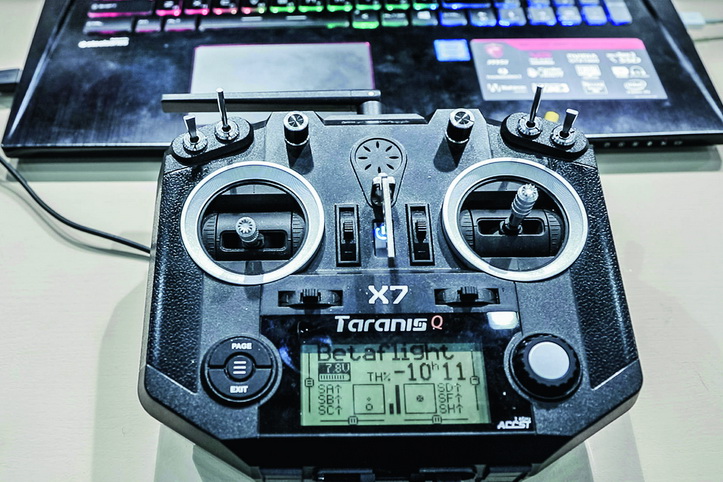
Aviation and cosmonautics are generally quite conservative in the sense of new technologies, the risk and safety requirements are too high. But now the industry is ripened: new tasks, new speeds, the intensity of information received by pilots and the accuracy of its transmission through the machine interface, analytical decision support systems - everything is moving towards a qualitative leap. The task of the developers is to simplify the interaction of a person with a machine and take into account modern experience in interaction with technical means: when touch screens are used in daily life, it is strange to see dials 30 years old in the cockpit. However, innovations must comply with all aviation standards and be certified.
Around the world, the development and implementation cycle of new solutions for crew information control fields has been delayed for many years. The most progressively developing class of business jets is small private jets, which are certified according to separate rules.
“This is where new technologies are being actively introduced, and buyers are ready to pay for it: touch panels, multifunctional knobs, augmented reality systems, synthetic advanced vision (SVS, Synthetic Vision System, and AVS, Advanced Vision System), circular review systems based on them,” enthusiastically lists Gleb Boyarskiy. “There are many technical solutions that are certified much longer in large aviation. In Russia, all aviation manufacturers are also interested in new technologies: everyone wants to develop."
The methodology developed at the Moscow Aviation Institute for Russian Helicopters Company can be adapted to most of the aircraft, including civilian aircraft. The work with Russian Helicopters Company in the laboratory is rated as rating in order to show the market its potential and attract the attention of customers.
From Teaching to Mentoring
“Building business processes, communicating with customers of the development is a great start,” says Gleb Boyarskiy. It was the Avionics Integration Laboratory that became his first job in the development of technical systems, after student projects. Previously, it was pure creativity: something to invent, design, draw, print on 3D-printers, engage in robotics. And now fantasy is focused on specific tasks that have timelines, results and payment, and which are dictated by the real problems of industry.
“MAI gives unlimited opportunities for growth and development to those who want to develop as a specialist,” confirms the specialist of MAI. “But in the laboratory I had practical experience: the ability to do business, not to be afraid to communicate with customers and competitors at any level, skills to build a dialogue. There are a few places that are as loyal to young specialists where I could get the same opportunity - to carry out a contract with Kronstadt Group from the first meeting to the signing of the act of accepting all works, from zero to the final.”
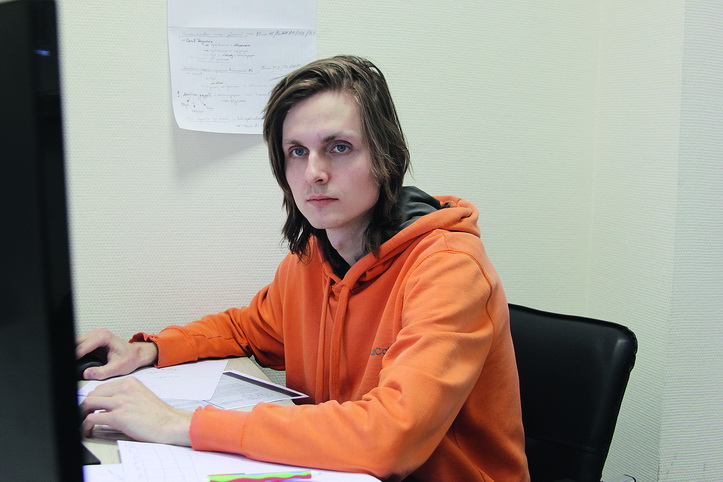
Now, third-year and fourth-year students of MAI work under the supervision of Gleb Boyarskiy in the workshop of ergonomics. The results of their work will be included in the report on the projects of Russian Helicopters Company which corresponds to the wishes of the customer - to connect students to the project. To begin with, the students were taught to work with literature, to analyze technical systems, work with documentation, with specific functionality of CAD programs, to build and apply mathematical models in the interests of research. Now those who are not expelled in the process of learning have become full-fledged employees. And as practice shows, they sometimes have much more enthusiasm for work than the old specialists. “The result was a chain of mentoring: Dmitry Nikolaevich Panyukov became my teacher in the laboratory, now we are bringing up students together, pulling them up to work on real projects,” Gleb Boyarskiy summarizes.
Engineers. Entrepreneurs. Leaders.
“About the guys who grew up under my command, I can say that each of them is an absolutely independent leader or entrepreneur” says Dmitry Panyukov. “They are ready not only to earn money, and with their intellect, but also to pull employees along. Probably, I was lucky with them: each of them is a leader, each is very able-bodied, self-motivated, and they are all hard workers. All the people, who I have grown up, continue to work.”
There are a few such leaders, they must be sought. The university is already fully preparing for this: MAI implements the concept of engineering and management education, in which technical disciplines are inseparable from business. “The market does not need purely technical developments. Such thinking needs to be changed,” Dmitry Panyukov is sure. ”Engineers must clearly understand how and where they embed the results of their activities. Without this understanding, the correct benchmarks are lost, people begin to automatically fulfill their duties.”
In addition to the projects with Kronstadt Group and Russian Helicopters Company, the laboratory has already completed a number of contractual work, including the creation of a concept for an integrated delivery system for the PJSC Sberbank. The volume of contracts and the number of customers is growing. The Avionics Integration Laboratory lives by its developments and production, not on budget subsidies.
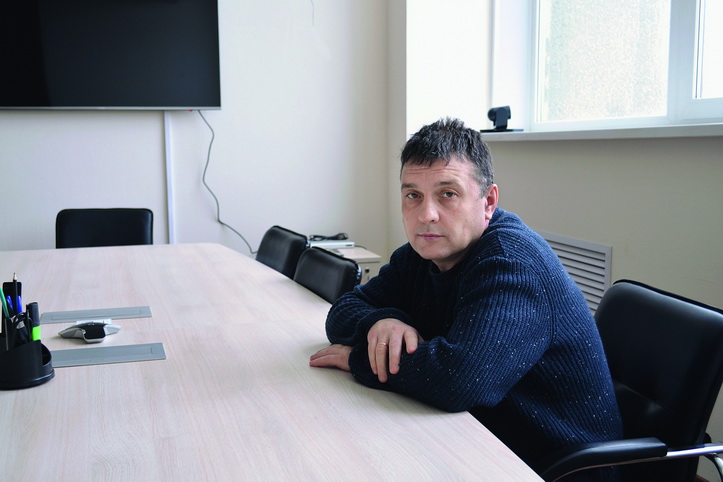
“We try to go to the market ourselves and bring money from the market,” says Dmitry Panyukov. “This scheme is the most difficult, but in the end the most correct. We understand exactly how to make money on the open market, and this understanding is passed on to students, our future colleagues and partners.”
“Students for the laboratory should be “grown up” from the second or third year,” the Head of the laboratory believes. To give a chance to work for half a year or a year, to carry out at least one or two projects so that they themselves communicate with customers, form a technical specification, prepare justifications, presentations, contracts and conclude them, conduct contracts entirely and see the future.
If such conditions for growth are not created inside MAI, the demanded and active students will go to third-party employers - from the fourth year students are already “bought out” with might and main. Therefore, not only the tasks, but also the salaries in the Avionics Integration Laboratory are interesting, this is not just a free pre-diploma practice.
“Our working conditions are comfortable, the nature of work and the social circle are very broad, the results of work are quite serious,” confirms Dmitry Panyukov. “Our customers and partners are large companies. The students communicate directly with people who build helicopters, lead programs in the field of aircraft, including with the first persons in the industry. Just like adults. We ourselves are earning here, looking for a market niche in Research & Technology, and young people are actively involved in all this.”
The plans of the laboratory are to open its own magistracy and engage in teaching at the university: to lecture, conduct seminars. This will be a course close to the educational work of the laboratory, and its program is already in preparation. Those projects that are now at the earliest, exploratory stage will be developed - they will reach “iron” in 2019-2020. New workers' hands and clever heads will be needed, new workshops and vacancies will appear for new leaders, brought up from today's newcomers.
MAI Drone School
Kirill, a MAI graduate of 2007, returned to the alma mater from the Sukhoi Design Bureau to work in the Avionics Integration Laboratory — he was engaged in the direction of the UAV, and by 2018 founded the Drone School, which operates on the basis of MAI.
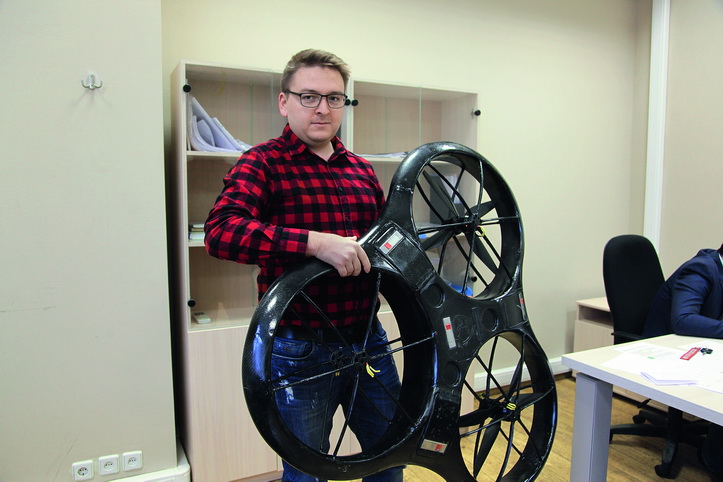
“It all started in October 2016, when we held the first drone racing championship (racing on high-speed drones with a first-person view). Competitions were held right on the Main Square of MAI, opposite the Building №3, and gathered not only students, but also a huge number of schoolchildren, prospective students of MAI. Back then this movement was just beginning in Russia, the speed of the drones were still relatively small, and the drones themselves were enormous, and still the process was exciting. For someone from those who were at that championship, it became a key event in life and led to the decision to enter MAI. Looking ahead, I’ll say that with one of these guys at the end of 2018 we won the first place on the WorldSkills in the competence of drones (these competitions are held for the second year, and both years we become their winners).
Back then, in the fall of 2016, I met young talented guys at races who construct drones and all kinds of gliders and airplanes. It was the backbone of the aircraft model club, which operated at MAI since the Soviet times. We decided that we need to develop, and began to hold various master classes, shows, go to schools and children's camps to which we were invited. They organized a two-week shift for drones at the All-Russian Children's Center "Smena" in Anapa: a drone that children themselves created and programmed from zero, flew to the mountains and took water samples from a mountain lake on request of the “chemists” from another Smena direction. It was a unique project!
At the beginning of 2017, we realized that in Russia we need to create the first team of the university in drone racing, and took up the training of piloting drone as airborne cars. And at the end of 2017, drone racing has already become the official sports discipline. In addition, we were engaged in research and development with the students. For two years we have made a lot of atypical drones: coaxial tricopters, octo- and hexacopters, airplanes and “flying wings”.
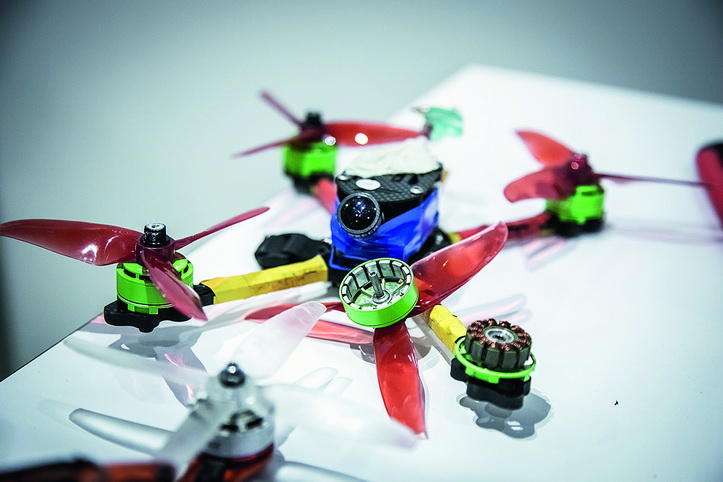
When not only friends, friends of friends and acquaintances began to come to us, but simply people from the street (“We want to learn how to fly!”), it became clear that it was time to open a school that would train professional pilots and drones operators on an ongoing basis. The Drone School has become my own project based on the Avionics Integration Laboratory. We are now at the finish line of the official registration of the company. This will be the first Russian Drone School, and with such a serious educational partner as MAI. Where, if not here, it had to be born!
Our school prepares professionals and just amateurs, even children who come out of curiosity. They do not have the opportunity to do this at home, and in class we provide all the instrumentation: glasses, equipment, drone, batteries. We fly in enclosed spaces on small drones. Those who want to progress in piloting can also fly large ones: MAI has its own airfield near Moscow for flight training. Drones for racing we make ourselves. Both small, 80 mm diagonally (these are more like toys, although they fly well), and large ones, 190–200 cm. Their speeds have increased significantly: our most typical drones can take at least 2 seconds to accelerate from 0 to 200 km/h. At the Drone School we teach to model and program. After all, in drone racing competitions you can participate with a drone, purchased or designed independently (we also have a custom-made drone assembly service).
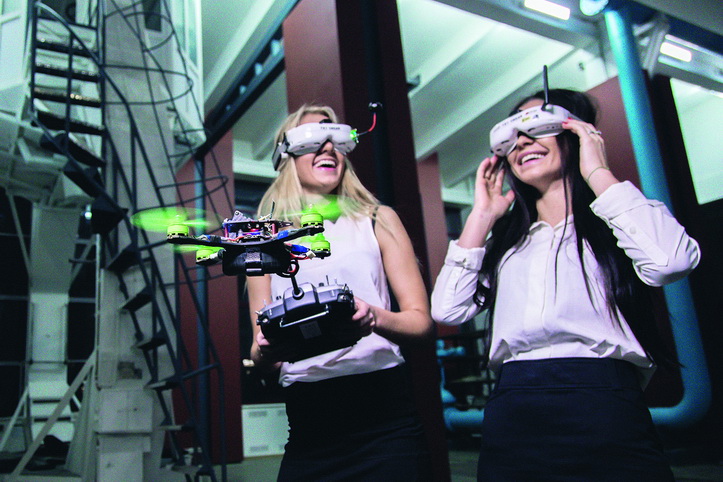
These races are analogous to Formula 1: you need to go through a specialized track cleanly, with maximum speed, without penalty points. The audience should see the race, from the first person inclusive: come with your helmet, glasses, tune in to the channel and watch the flight.
Our teachers, who started with the development of this competence, are really passionate about their work. At the start of the work of the Avionics Integration Laboratory, Dmitry Nikolaevich Panyukov asked me to engage in attracting young specialists. And now our Drone School attracts young people - the young people can feel themselves in business, earn money and have the opportunity to implement their ideas already in the first or second year.
We were one of the first in Russia who started shooting unique and popular content for drone racing: exciting car chases, super cool filming in the mountains, in inaccessible places. Now we are fulfilling the request of the capital authorities for shooting Moscow. Over the year, we performed about a thousand sorties on specialized vehicles, and we do it officially: each flight is coordinated in special agencies.
Our other trend project, born out of our own ideas and enthusiasm, is aerotaxi. The device is now in development. We are looking for an investor to create a prototype in real size: a single-seat aerotaxi in which a person could perform a short flight. We are planning to make the layout by the summer 2019, but we'll see. Another promising direction is, of course, delivery with the help of racing drones.”
Platon Maximov
A 16-year-old drone pilot from Moscow, a graduate of the MAI Drone School, a multiple winner of the FAI (Fеdеration Aеronautique Internationale) world series of races.
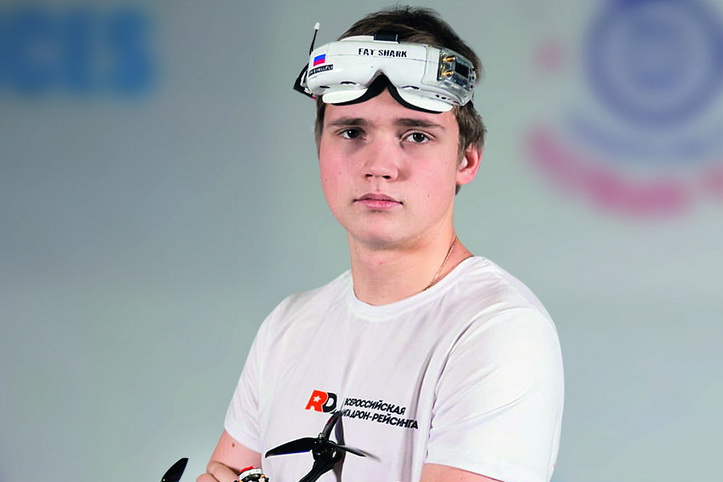
“I started drone racing four years ago when this sport first appeared in Russia. I saw on the Internet big drone racing competitions in Dubai and plunged into the life of drone racer. At first, I trained myself, but clearly lagged behind in the technical part, so I began to look for some schools or classes where I can be taught how to design drones. This place was the MAI Drone School, where real professionals work. I met Kirill Schukin at the VDNH, at one of the first drone racing tournaments in Moscow organized by the Drone School. And then I went to classes, learned what the drone consists of, what to look for when assembling and how to make the drone faster.
Now I assembly all the drones myself without any problems and went into “free flight”: last year I took second place in the FAI world ranking, traveled around a dozen countries and became a famous pilot. I prepare to fly with the Drone Sports Global team in the biggest league - Drone Champions League (DCL). I have a dream to conquer the pedestals of drone racing. And I know that everyone can reach such heights by starting to learn from school years and stubbornly striving for their goal. And I continue to be friends with the Drone School. I am invited to perform at large events, test new techniques and conduct training.”